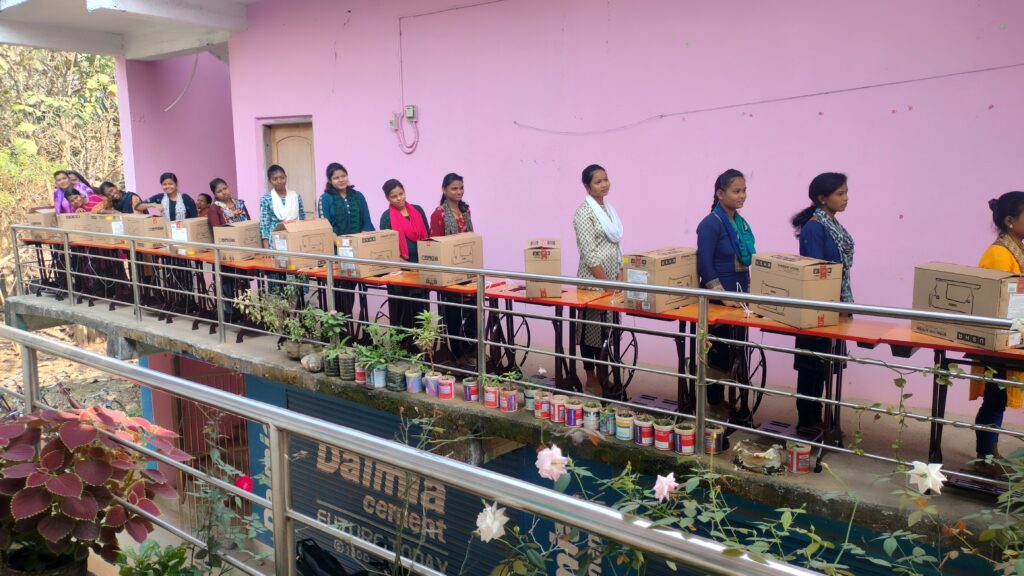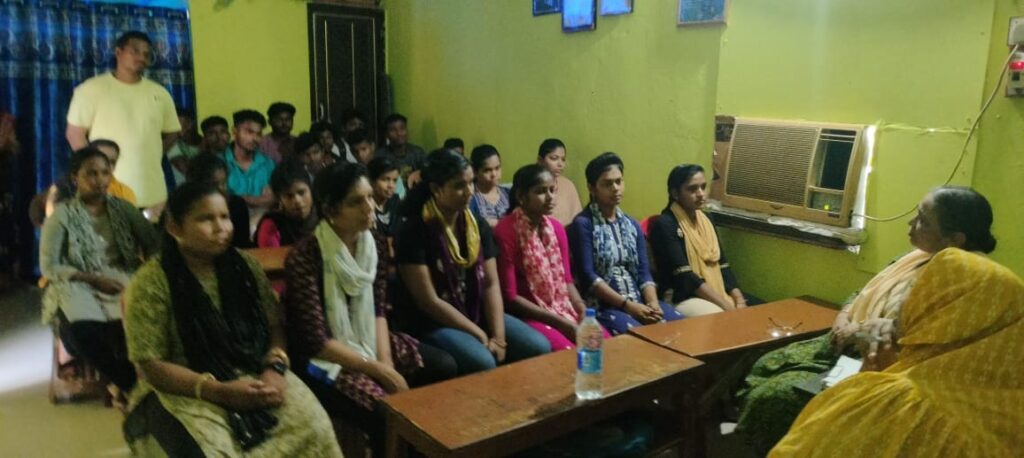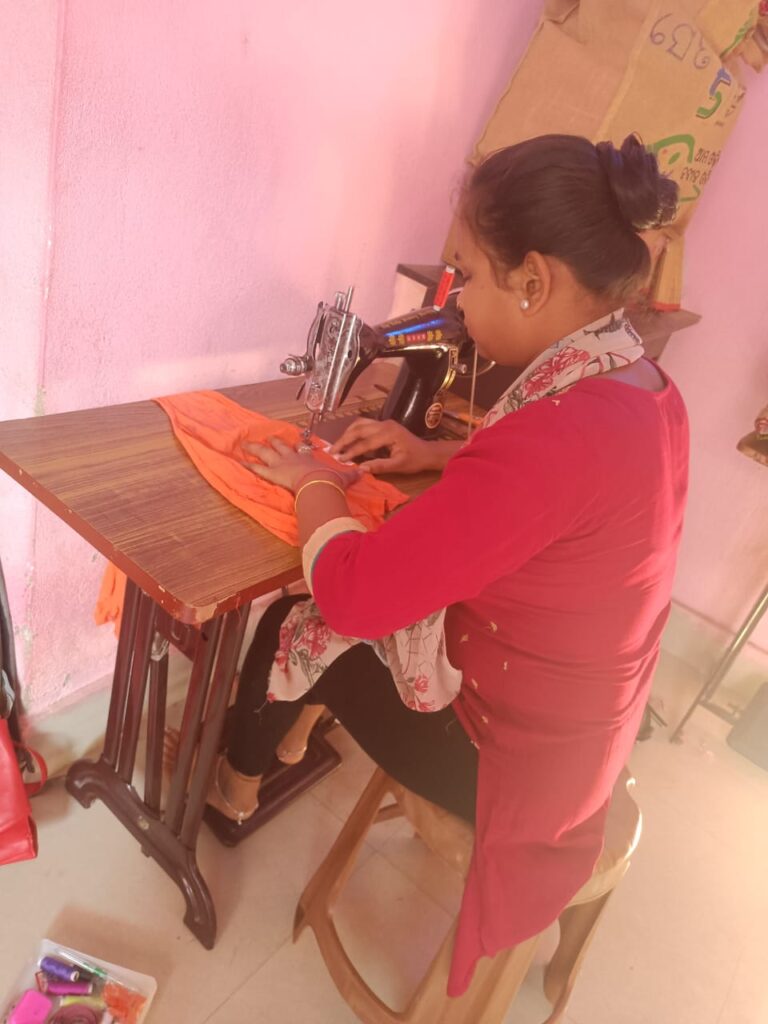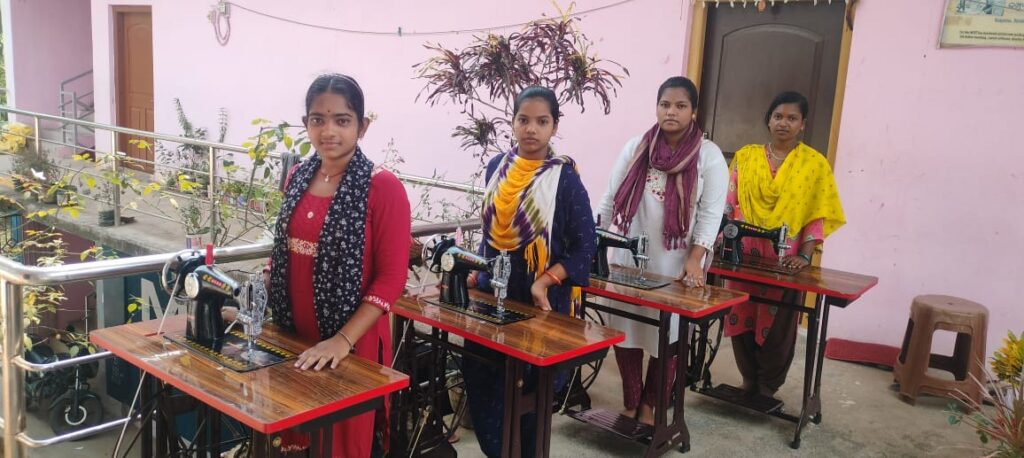By: Dr. Annapurna Devi Pandey, Professor of Anthropology at University of California, Santa Cruz

Jane Goodall, the renowned primatologist, insists on writing, talking about, and spreading stories of Hope—people tackling what seemed impossible and not giving up. Those stories should have equal time because they give people hope” ( New York Times, 16 March 2024).
Amid the challenges we are facing in the world, I would narrate a story of hope. Through a non-profit South Asia Study Initiative (sasi.org) that I started with a few like-minded people in the USA, I have had the opportunity to work with varied groups of weavers across Odisha. I have learned to admire the strength of indigenous weaver communities in Nuapatna, Odisha. I have learned how they embrace new opportunities, overcome challenges with determination, and engage in self-reflection to foster personal growth.
I was introduced to 35-year-old Gayatri Patra and 24-year-old Sunil Rana in 2019 through a designer friend when I started the South Asia Study Initiative (SASI), a U.S.-based nonprofit organization to work with indigenous weavers in India. Sunil and Gayatri run the Digital Empowerment Foundation (DEF) in Nuapatna. Sunil manages the computer center, and Gayatri leads the sewing center. The two initially joined the center as teachers, but at the end of 2019, due to a lack of funding, the NGO closed its office in Nuapatna and asked them if they would take over the center.
This center is a haven for girls around the weaver villages. The young women who come to learn sewing mainly belong to impoverished families in the cluster of weaver’s villages. After high school, poverty and family responsibility have kept many from higher education or professional skill training. They realize there needs to be more money in weaving as a profession. They help their parents and family in weaving and come to learn an income-generating skill. They hang out with one another, and it is their only social place outside their homes.
Gayatri’s Story


Gayatri, who has never left the village, and Sunil mustered the courage to run the center with ten computers and six sewing machines. They had to pay the rent for the building and take care of all the operational expenses. They started with six students, and in 2023, the student strength has reached 140. The center, operational during the COVID-19 pandemic, trains young local people for their livelihood and finds small, effective ways to influence young women, their families, friends, and the village community. It provides a social networking space for these young women outside their homes. Sunil runs three to four batches of computer classes with 15 to 20 students each.
Gayatri belongs to a weaver family, but her parents are too old and ailing. As a result, they are not able to work anymore. Their two tantas ( looms) are lying dejected. She got married at an early age and lives with her parents. Her husband is short-tempered and physically and emotionally abusive. Her young daughter adds to her worry as the in-laws consider a girl child a burden rather than a blessing. She is soft-spoken but very assertive and is looked upon as a mother to the young women who come to the center for sewing and computer classes.
Sunil credits her for the overwhelming response to the center. Young women from several villages come to Gayatri for sewing training. The students admit that she is short-tempered and gets moody. But she nurtures ambition in women to succeed, learn new skills, and get a job. Many girls have turned to marketing their weaving products without any middlemen. Belonging to the local community, they both exude a sense of agency, a feeling of duty, and ethical integrity to help find the voice of numerous young women, learn new skills, and develop personal growth.
Nuapatna is well known for Ikkat saris, and we, as part of the South Asia Study Initiative (SASI), have been working with the weavers to set up a website, creating a global marketplace for their beautiful handloom products. We have been keen on learning about the everyday challenges of the weavers and their families, especially women, and how we could facilitate the demands of handloom products worldwide. This center is a haven for girls around the villages. They come to learn a skill and hang out with one another, the only social place for them outside their homes.
SASI has been working with Sunil and Gayatri since 2019 to promote the artisans in Nuapatna and provide them with a free global platform on a worldwide market website. These young women hail from impoverished families where their fathers work as laborers, tailors, farmers, and cow herders besides weavers; many are too old or disabled to work. Their suffering is immense, but they do not carry it on their sleeves. They all have ambitions to be successful, learn new skills, get a job, and care for their families.
Women’s Empowerment
On my visit to the center in 2022, I met Rashmita, one of the many women trained by Gayatri, on Dec. 20, 2022. The timid 38-year-old clad in a cotton sari looked sad and lost. She admitted to having many problems at home. Gayatri told me that Rashmita came to the center about two years ago to learn to sew. Fearful and traumatized, she could not handle physical and mental abuse at her husband’s home and moved to her father’s with her five-year-old son. At the center, Rashmita could not remember simple steps such as putting thread into the bobbin. Her brother said she was worthless. However, Patra was persuasive, and Rashmita was persistent. She wrote down every step of her lessons; it took her two years to complete a three-month-long course. Now, she has become competent at sewing. Patra has ensured her success in sewing, as it is her only way out of her daily struggle.
In 2022, on behalf of SASI, we facilitated professional sewing and advanced computer training for young women, and in December 2023, SASI raised money to provide 24 sewing machines.
On 10th Dec 2023, I rented a taxi from Cuttack around 9 am, drove about 60 km, crossed the bridge on the mighty river Mahanadi, picturesque hills and forests with a signboard that wild elephants cross this road, and arrived at the Digital Foundation center, Nuapatna, around 11 am. Several young women in colorful salwar kameez and saris were waiting. These young women bicycled five to fifteen kilometers from their homes to meet with me. Gayatri, the sewing teacher, brought me fresh-cut flowers from the potted plants on the first floor of the building. The flower pots stood out to give a welcome feel to this bare concrete space. On the first floor, one room is devoted to computer training; across the corridor, another is dedicated to sewing training. The young women who come to learn sewing mainly belong to poor families in the cluster of weaver’s villages. After high school, poverty and family responsibility have kept many from higher education or professional skill training.


When I arrived at the center, there were rows of sewing machines, 24 waiting for distribution. The girls, beaming with joy, collected their machines individually, and their father, brother, and uncles came to help them carry the machines. One young woman in her twenties came from a remote village about 15 kilometers away. She told me her story – her father, a small-scale farmer, had just lost all the vegetables in his field to some insecticide he had misapplied to the plants. She said,“ Madam, my father is having a hard time taking care of my and my sister’s education. This machine will be my life savior, for me and my family financially”. On behalf of SASI, five core members contributed to buying these young women who had no means to buy one for themselves. I felt like I received a million-dollar lo had received a million-dollar lottery; the happiness on the faces of the girls would not match any recognition I had gotten. the machine at home will enable these trained girls to earn a living for their families.
I met Rashmita, one of the many women trained by Gayatri, on Dec. 20, 2022. The timid 38-year-old clad in a cotton sari looked sad and lost. She admitted to having many problems at home. Gayatri told me that Rashmita came to the center about two years ago to learn to sew. Fearful and traumatized, she could not handle physical and mental abuse at her husband’s home and moved to her father’s with her five-year-old son. At the center, she could not remember simple steps such as putting thread into the bobbin. Her brother said she was worthless. However, Gayatri was persuasive, and Rashmita was persistent. She wrote down every step of her lessons; it took her two years to complete a three-month-long course. Now, she has become competent at sewing. Gayatri has ensured her success in sewing, as it is her only way out of her daily struggle.
These young women would like to become accomplished seamstresses and showcase their handloom weaving and textiles their village is famous for.
SASI’s initiative is a drop in the ocean. Through technology, we are building relationships in this virtual, disconnected world. These young women prove that sewing as a technology generates confidence and community. They face multiple constraints growing up poverty-stricken. However, given the opportunity, they strategize their position in the family and community to create their own space. These young women weave relationships with one another and convince their families that the new skills, such as sewing, computer skills, and general education, help them increase the family’s income and provide them with a greater sense of self-worth.
Their access to technology has helped them enhance collective sewing, and their working together establishes a sense of community connecting with us.
I visited the girls’ families after they took the machine home. Some mothers were making leaf plates on their porches, and some were preparing cow dung cakes for the hearth fire. The girls were so happy! One of the recipients was a mother of two high school kids, and her husband was a weaver. She said that her daughter will learn sewing now, and together, they will help supplement the family income and her studies.
But everything could be better. Sunil laments that he has no extra earnings; his family pressures him to get a steady income and get married. Gayatri’s family situation is dismal; she does not have any means to make more money, and she sometimes feels life is useless if she cannot provide medicine for her ailing parents. But seeing the women making a difference, she realizes that breaking the boundaries of social norms is not always easy, but it is not impossible. As for SASI, we support the center with Gayatri and Sunil to sustain the zeal and energy of the girls who have hope and ambition.

Sunil and Gayatri’s efforts to motivate the artisans to be self-governing and self-supporting have failed. There are many barriers: young women face family constraints to get married at an early age, curtailing their dream to be self-reliant, and the lack of availability of jobs in the villages makes it hard for women to be self-dependent. Even if small shop owners hire these talented women, they do not pay them and harass them after long work hours. Yet, Gayatri and Sunil persist in creating an ideal community without hierarchy and collaboration in sharing resources, know-how, and mutual support. In a neoliberal society, their successes (and there are some) and failures point to the challenges of creating a sustainable life within market capitalism and state-sponsored lopsided development.
However, their efforts introduce us to a new awareness, and the wisdom of rural artisans will help guide us in recentering ourselves. They promote a sense of equanimity and democracy in a hierarchical society. Professor George Santayana used to say that we live in two worlds — one given to us by nature, and the other we create ourselves in our stories, life experiences, poetry, prayers, and other things we create. These two worlds are interconnected, and our acknowledgment will center us and make us feel less alienated.

